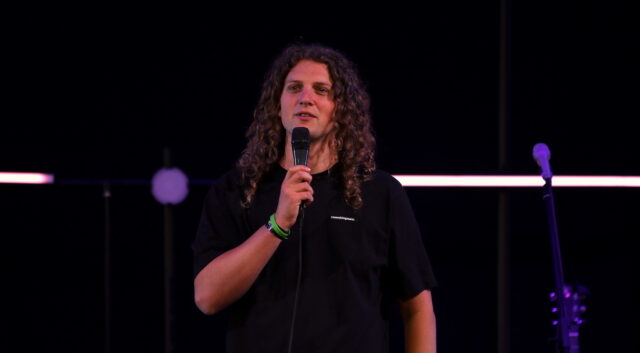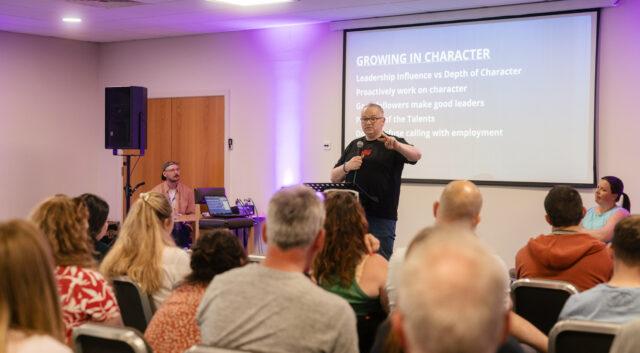Katie explores the biblical teachings that children can be both filled with the Holy Spirit and the recipients of spiritual gifts, with practical examples.
There is so much controversy surrounding the idea that children can be both filled with the Holy Spirit and the recipients of spiritual gifts. Most people are happy enough to accept that children can be filled with the Holy Spirit, but it is common to encounter much caution and even opposition, when it is suggested that children should be fully involved in power ministry.
When Peter addressed the crowd on the day of Pentecost, one of the first things he says is this: “In the last days, God says, I will pour out my Spirit on all people. Your sons and daughters will prophesy, your young men will see visions.” And later on, “Repent and be baptised, every one of you, in the name of Jesus Christ for the forgiveness of sins. And you will receive the gift of the Holy Spirit. The promise is for you and your children and for all who are far off – for all whom the Lord our God will call.” (NIV) It’s for you and your children, and in the Vineyard we believe the Lord has already called many of our children. There are no age categories in the question of who can receive and be used by God and therefore we expect our children to be fully involved in ministry of the Holy Spirit. Receiving and operating in the gifts of Holy Spirit is part of being a Christian. Children are clearly included in this and we take seriously the need to teach the full trinity to our children.
There are no age categories in the question of who can receive and be used by God.
Biblical examples
It may be helpful for you to look up some examples of how God uses children in the Bible. Some examples are Naaman’s servant girl (2 Kings 5), David (1 Samuel 16), Samuel (1 Samuel 3), Joseph (Genesis 37), Josiah (2 Kings 22), The boy who shared his lunch when Jesus fed the 5000 (John 6), the children outside the temple in (Matthew 21), and Jesus himself as a boy in the temple (Luke 2).
Teaching Kids to Pray for Healing…
So how do we do this with kids? Start by praying for someone as a demonstration. Ask if there is anyone who would like you to pray for them and invite them up to the front. Ask them to close their eyes and put their hands out ready to receive, because when their eyes are closed they can focus on God and when their hands are open it shows that they are ready to receive his touch.
When we pray for someone we are like a drainpipe for the Holy Spirit.
Captain Alan Price method of praying for kids which he calls ‘drain piping’ is simple and useful in the context of kid’s ministry. He suggests we can ask all the children to describe a drainpipe. What does it look like? What does it do? Explain that when we pray for someone we are like a drainpipe for the Holy Spirit. Invite a few children to gather round and help pray. Tell the children that we are going to make the shape of a drainpipe with our arms. Each child should stretch one hand towards heaven, because it’s God’s love power that brings healing. Explain that healing means being made whole, so we do not need to be sick in order for God to heal us and make us whole. We all need more and more of this. Remind them that heaven is at hand. We want to reach up our hand to get whatever blessings God has for people, but then we want to reach out our other hand to the person we are praying for and pass on what the Holy Spirit wants to give or say. Get the children who are praying to stretch out their other hand or gently touch the shoulder of the friend they are praying for. Explain that we are like drain pipes because God chooses use people like us as channels of his love and power, flowing through us and blessing or healing the person we are praying for. It’s so simple, and leaves the children in no doubt that it is God who does the healing, not us!
…The Vineyard Way!
In the Vineyard, we teach adults who want to learn to pray for healing a simple 5 step prayer model. It’s so easy and accessible, that even our toddlers can learn to join in with it. In fact, if we build ministry into our programmes every week from the Babies up, and if it is part of our church culture for our kids to see the adults ministering in this way, it very soon will become just part of how we serve our friends and are served in return.
Our kids know that God is interested in the minutest of details in their lives.
Getting started. Who do we pray for and what do we pray about? In the Kids rooms, there is usually no shortage of volunteers. Our kids know that God is interested in the minutest of details in their lives. They know he cares about their bruised knee, or their cold, or their grade one piano exam. Adults tend to fuss and worry that maybe their thing is too insignificant for prayer, or too trivial. Not so much with kids!
As leaders we need to be asking God to highlight specific children to us, and asking him for specific revelation concerning the children in our care, that we might minister as effectively as possible. Jesus only did what he saw the father doing, and in kids ministry it’s no different. Look at them, pray for them and ask God what he is doing in their lives. Ask the children. Who do they think we should be praying for? Is God speaking to them about anyone of their friends in particular? Make sure that you offer prayer to any of the children that want it, whether they have been highlighted to you or not. Ask them what they need God to do for them / help them with. Pay attention to the questions they are asking. It may be that on a particular week, lots of issues could arise from the things you are teaching on and from discussions happening at snack time. Be alert to what the Father is doing
Jesus only did what he saw the father doing, and in kids ministry it’s no different.
Step 1
In the Vineyard we call this the ‘interview.’ We need to find out what’s wrong? Where does it hurt? What would you like Jesus to do for you? We need to listen to them and listen to God. With children this stage will be much quicker than with adults, as you won’t have to listen to apologies and insecurities about whether they should even be getting prayer, or lengthy medical histories. Kids are straight to the point and it makes praying much less complicated.
Step 2
We call this the ‘diagnostic question,’ when we find out what the cause is, what is going on, why do they have this problem. This will often blend into step one with kids.
Step 3
Prayer selection. What sort of prayer do we need? With children we have to be very practical and Chris Leach in her book ‘Children and the Holy Spirit’ suggests that we can actually teach them set phrases to use when praying, which can very useful. For example, to ‘break the power of’ fear or anxiety; to ‘command’ bits of the body to be healed or to move back into place; to ‘set free’ the victim from their illnesses; to ‘cut them off’ from unhelpful things. All these things should be taught in the appropriate context, focusing predominantly on the fact that God heals and not the words we speak anyway. We must teach kids to hear from God when they are praying, but teaching them particular things to pray will give confidence to select an appropriate prayer to use when God has spoken to them.
Kids are straight to the point and it makes praying much less complicated.
Step 4
Ministry time, where we need to pray and look to see what is happening. We need to teach children to pray with their eyes open. As you do this yourself, watch and ask questions to the children. It won’t disturb the Holy Spirit or affect the healing process. It is important to be brief. The kids need to know that they should just ask the Holy Spirit to come and then wait. Just ask one of them if they would like to just say ‘Come Holy Spirit.’
It is very important that we teach children to see the presence of God. Teach them that it’s fine to sit quietly and wait. Don’t be vague about this. Children need specifics if we are to avoid confusion. Teach them to keep their eyes open and to watch for physical changes such as trembling, eyelids fluttering, swaying, breathing deepening, a peaceful glow, laughing, crying, falling, heat or coolness. Teach them to look out for these things as a sign of the Holy Spirit. Teach them to enjoy and welcome his presence. We don’t need to teach every manifestation at once, but kids must understand that there is little use praying until we have some clear evidence of the Holy Spirit being there.
Just ask one of the kids if they would like to just say ‘Come Holy Spirit.’
When you get down to the actual praying, it is important to get to the point. Don’t use complicated vocabulary, and in fact don’t use much vocabulary at all! Kids don’t waffle anyway and if we take a good look at times when Jesus prayed for healing we will see that neither did he, so we’re onto a winner. They are more than happy with “Dear God, please make this sore arm better.” Simplicity is the key. Speak simply and directly to the sickness. Ask the child what is happening. Are they feeling anything? Do they think God is saying anything to them? It won’t get in the way of the Holy Spirit or the healing, and it will keep all of the children engaged and unconfused. And we all like to know how we’ve gotten on. Has it worked or do we need to try again. Children are naturally supernatural, so we could learn a thing or two. It’s good for everyone concerned to ask what happened. Often children will share that they feel peaceful or that they thought Jesus was holding them close. Children who have been doing the praying have reported heat flowing into their hands, and pins and needles when they were laying hands on their friends. Children have shared that they have felt a feeling like God’s power running down their arm at the same time their friend felt God touch them. With kids make no assumptions, and ask everyone concerned what they experienced, so that no-one goes home confused.
Finally, step 5
Post prayer direction. What do they do now. This is where we help them process what has happened. Have they been healed? We want to be real, so if there has been healing, as with adults it needs to be verified. Do they need more prayer, can we show them specific things in the Bible? It is important also to encourage them to give thanks themselves, and it is great if you can build in worship times for this purpose. And finally, encourage them to share what has happened with their parents. Testimony is so important and we must build it into kids’ ministry too.
Teaching Kids to Hear God Speak.
What we want to do is see our kids learn to hear God’s voice and realise how it most commonly comes to each of them. Again we need to tell children what might happen and also what role they play. Chris Leech helpfully suggests that we teach that revelation might come in one of five ways. You see it (a mental picture), you hear it (audibly or in your mind), you feel it (a sensation or pain which may show how God feels about a certain situation or indeed highlight a need for healing), you know it (an overwhelming certainty about something), or you say it (it comes out of your mouth before even thought about it). The main thing is that they just have to deliver what God says and that’s all. The leaders can worry about what to do with it.
How do we teach children about receiving pictures? Acts 2:17-18 quotes the Old Testament prophet Joel, saying “In the last days, God says, I will pour out my spirit on all people. Your sons and daughters will prophesy, your young men will see visions…” Pictures are an easier way of explaining visions. Look at Jeremiah. He started his training with how to receive pictures “What do you see… you have seen correctly for I am watching,” and this is a great model.
We must explain that people have different kinds of pictures, some have pictures which are like a photograph, while others see more of a video clip in their mind. Some see colours or shapes and others see words appearing.
Graeme Young suggests a simple experiment which is very useful. Invite the children to take part in an experiment to see what it’s like to receive a picture from God. Ask the children to make a picture of a house in their mind. When they have done that ask a few of them what their pictures are like. Explain that if you asked them to make a picture of a car in their mind they could do that. That’s the sort of picture we are talking about, but not one you decide to think about – rather, one that just appears in your mind when we ask the Holy Spirit to come and speak to us.
Like postmen, we must deliver it and then it’s up to God to show what it means.
Pray for the children. Explain that we are going to see what it’s like now to get a picture from God. Ask them to put their hands out ready to receive, and explain that you are going to pray for them and ask the Holy Spirit to put a picture in their minds right now that will be special for us. When you have finished, you need to take some time to share. Experience suggests that most children do seem to get a picture, but be careful to ask a few questions as sometimes there can be more than the child initially shares. Children can sometimes assume that you already know all about their picture just because you are a grown-up! It can also be a good idea to have pens and paper for children who may find it easier to draw their picture and then talk about it.
Interpreting pictures
Do ask the children if they know the meaning of their picture. You will be surprised! But make sure they know they are not to try and guess what they mean and use their own imagination. Talk to them about how we need to ask the Holy Spirit what it means. We must make sure they know that all prophecies should be tested, to see if they make sense Biblically and in reality. Explain that it may be for them, or for someone else or a number of people. Also it may be something special for now or it may be for the future. The important thing is to deliver the message. Like postmen, we must deliver it and then it’s up to God to show what it means. Most words will be a mixture of what is from God and what is from us, but that’s the same for all ages, and we can still benefit greatly.
The most important thing we can do as leaders is to model the gifts. Children will not learn about prophecy if they do not see it in action in the lives of their leaders. We need to move confidently in this so they can see it as well as learn about it. Be on your knees for our children, asking him to show you how he sees each of the little ones in you care, and what he has ordained for them even in the womb. We believe that God has an exact word for each child in your kid’s ministry, so pray, pray, pray!









